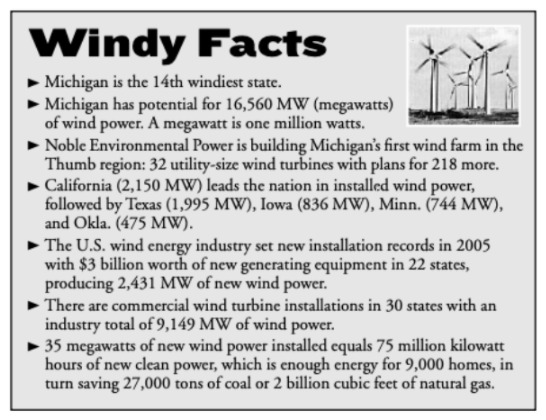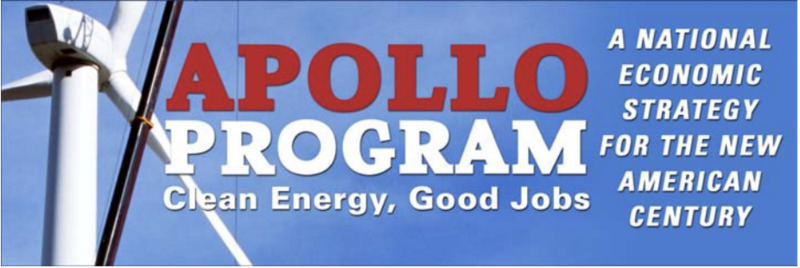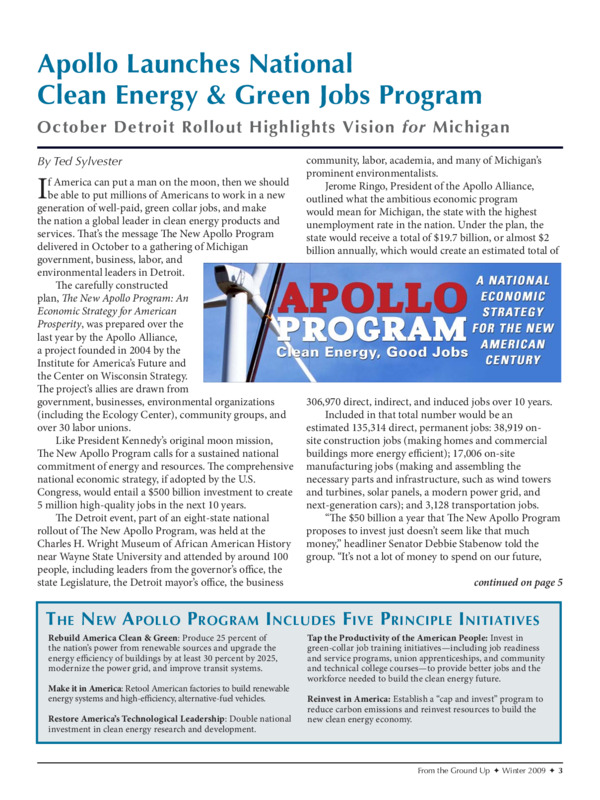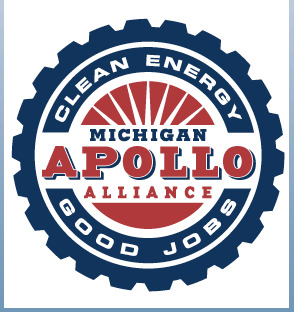Clean Energy and Power
Throughout the early 2000s, the Ecology Center helped advocate for and bring attention to many clean power and energy initiatives. While progress towards cleaner energy was (and continues to be) slow and tedious, the Ecology Center was tenacious in their approach, making many small but important steps in creating a more cleanly-powered Michigan.
To kick off the start of the new year in 2006, Ann Arbor Mayor John Hieftje introduced his plan to boost the city’s use of renewable energy to 20% for the city government by 2010 and for the entire city by 2015. The plan called for the city to get most of this clean energy from windmills, a technology that was just starting to spread in Michigan – the first windmill in the state had been built a year prior. Not only did the plan cut the city’s dependence on unclean sources of energy, but also was designed to lower overall costs. The Ecology Center supported the Mayor’s plan, seeing it as a great starting place for an eventual clean energy transformation for the entire city and even state.
DTE’s Greenwashing of their “GreenCurrents” Program
Although the City of Ann Arbor was taking proactive measures in transforming their energy system, one out of the two of Michigan’s largest energy companies was not. Rather than invest in clean energy solutions, DTWgreenwashed – misleading the public to think that a company and its product is more environmentally friendly than it actually is – one of their energy initiatives. In an August 2007 press release, the Ecology Center formally criticized DTE for their new “GreenCurrents” program. DTE marketed the option as an opportunity for customers to pay a premium for DTE to use renewable energy sourcing.
The Ecology Center noticed, however, that rather than purchasing wind or solar power to use in their grid system, the DTE program used its revenue to buy renewable energy certificates. These signified that somewhere, at some point in time, clean energy was used, not a direct DTE-to-consumer green energy line. The Ecology Center started publicizing the issues with GreenCurrents, pointing out that Michigan customers were not reaping the monetary and health benefits of DTE using renewables, since the company was still spending extra money to import coal or uranium and using pollution-heavy methods of delivering energy that impacted the air quality of the state.
After looking through DTE’s filings with the Michigan Public Service Commission, the Ecology Center discovered that not only was the GreenCurrents program not buying or using renewable-produced electricity, but it was misallocating the funds altogether. The documents the Ecology Center reviewed showed that in GreenCurrents’ first year, over 85% of the program’s costs went to marketing and administrating: using money intended to go towards investing in clean energy to instead promote how ‘environmentally-friendly’ DTE was being. “Detroit Edison’s GreenCurrents program is long on ‘GreenWash’ and short on actually delivering renewable energy,” said David Wright, the Ecology Center’s Clean Energy Program Director, in an October 2008 press release. “Detroit Edison does not purchase any renewable energy for GreenCurrents customers, the program is incredibly expensive, and it is structured so that it will always be expensive. DTE customers and Michigan’s environment and economy deserve better.”
The Ecology Center continued to publicly criticize DTE for the GreenCurrents program in the years to come. An article in their Winter 2009 issue of their From the Ground Up environmental newsletter continued to remind people of the problems with GreenCurrents, arguing that ultimately the premium costs take money from Michigan customers and are not used to invest in “renewable Michigan-made electrons flowing into DTE’s lines” whatsoever.
DTE “retired” their GreenCurrents program after nearly a decade in 2019, replacing it with a fairly similar program. MIGreenPower, GreenCurrents replacement, has presented its own case of misleading marketing and associated problems.
Clean Energy Efforts During Governor Granholm’s Administration
Governor Jennifer Granholm ushered in a new era of clean energy initiatives throughout the state of Michigan during her tenure. Working with other Midwest region officials, she helped get five other state governors and one Canadian premier to sign the Midwestern Greenhouse Gas Reduction Accord at the Midwestern Governors Association Summit in 2007. At the same Summit in 2009, she and other Midwest governors formally adopted a document, the “MGA Energy Security and Climate Stewardship Roadmap” – which was composed and championed by representatives from utilities, agriculture, labor, and environmental groups, including the Ecology Center – in order to establish an outline of how to make robust, economically beneficial investments in clean energy. While much action still needed to be taken by the end of her Governorship, the strides that were made helped to push Michigan in the direction of a cleaner energy future.
In early 2009, Governor Granholm introduced a new clean energy plan for Michigan. The Ecology Center urged the public to support her “bold plan” for Michigan, which included provisions for instituting renewable energy payments, putting the brakes on coal, investing in efficiency, and establishing a “Michigan Saves” initiative to help residents overcome initial cost barriers regarding renewables. The Ecology Center actually had been helping to develop the “Michigan Saves” initiative. She also formed the Michigan Climate Action Council (MCAC) to investigate ways to reduce Michigan’s GHGs. In July of that year, the MCAC issued its final report with 54 recommendations to cut the state’s GHGs 80% by 2050 while protecting its economic future, which the Governor reaffirmed her administration’s commitment to in an Executive Directive (2009-4). The MCAC was a 35-member group composed of leaders from manufacturing, automotive industries, utility companies, environmental groups, universities, and government. The Director of the Ecology Center, Mike Garfield, was one of the leaders appointed to serve on the Council. “The Climate Action Council report, and the Governor’s subsequent first step toward implementation, thoroughly debunk the argument that dealing with climate change will wreck the economy,” said Garfield in a press statement that July. "It’s remarkable that the major greenhouse gas emitters in the state came to the conclusion that bold, immediate steps are not only necessary for our climate and environmental future but also are beneficial for Michigan’s economy.”
However, after much revision and opposition from the legislature, at the end of the year Governor Granholm ended up signing into law “a package of bills to promote energy efficiency,” although they were “admittedly weak” as explained by Ecology Center Director Mike Garfield in an article he wrote for From The Ground Up (left). The legislation included energy efficiency programming that required a 1% annual reduction in electricity demand (which “could give Michigan one of the strongest efficiency laws in the country”) and a requirement of 10% renewable energy generation by 2015. However, that provision included enough loopholes that the American Wind Energy Association had ended up opposing the bill due to its “toothless enforcement provisions.” While the Ecology Center supported measures toward clean energy, they argued that the bills were not enough to put Michigan on the right trajectory. Mike Garfield argued in his article that what the state really needed to do was “adopt an aggressive agenda of CO2 regulation, a low-carbon fuel standard, tough building codes, and ‘feed-in tariffs’” in order to best place themselves as clean energy leaders in the country.
Although the clean energy proposal the Ecology Center initially supported did not end up being passed in its entirety, they still were able to work with nongovernmental organizations to push for cleaner energy both locally and nationally. In 2009, the Ecology Center worked closely with the Michigan chapter of the Apollo Alliance as the national organization released their New Apollo Program: An Economic Strategy for American Prosperity that focused on pushing America forward with clean energy and green jobs through five principal initiatives (right). The Apollo Alliance – taking its name after President Kennedy’s original moon mission, since it too called for a sustained national commitment of energy and resources – was a project founded in 2004 by the Institute for America’s Future and the Center on Wisconsin Strategy. Their Economic Strategy publication called on Congress to adopt their plan, which would have entailed a $500 billion investment in order to create 5 million high-quality jobs over the course of 10 years. While their economic plan never ended up getting adopted whatsoever by Congress, their proposal nonetheless got the Ecology Center and other environmental groups working with labor, business, and government officials on how to generate ambitious plans for America’s energy future: a skill they are still using to this day through their advocacy work supporting the Green New Deal.
Article written by Lily Antor, member of the Spring/Summer 2020 Research team.








